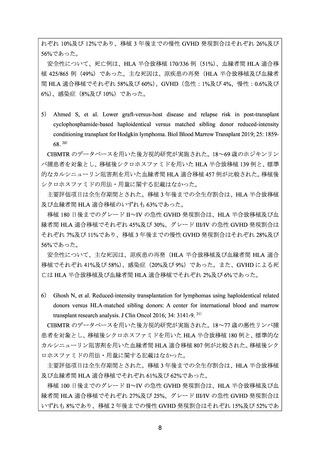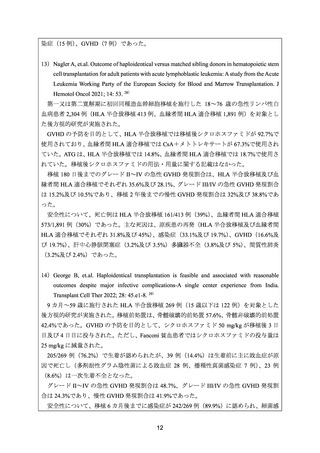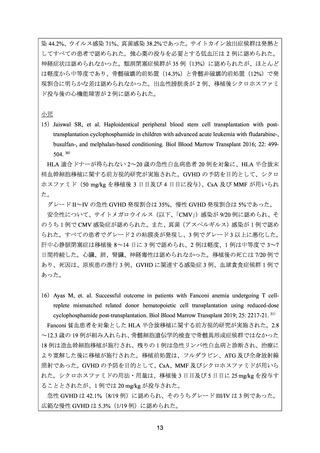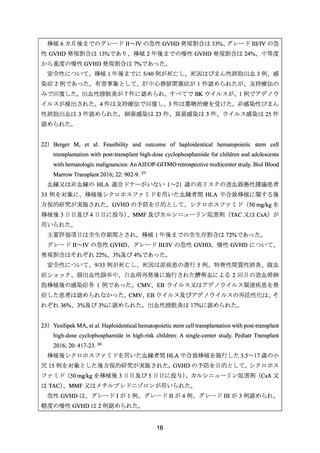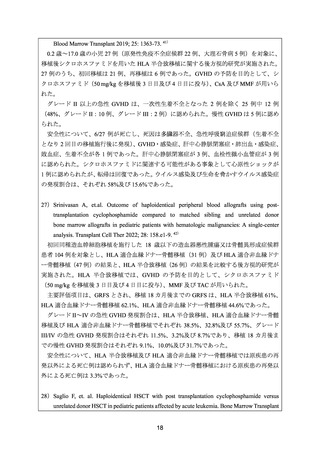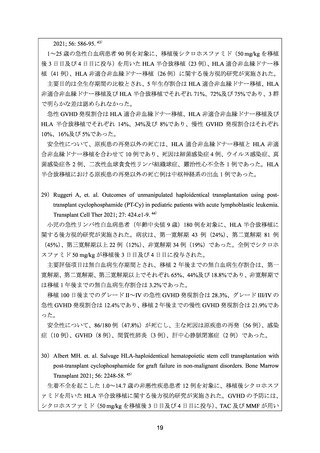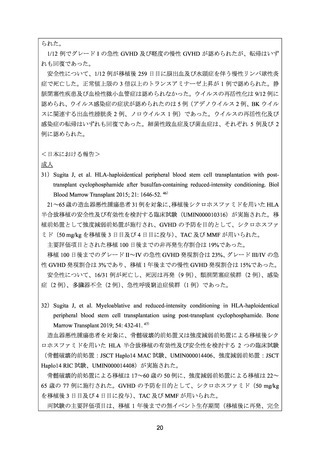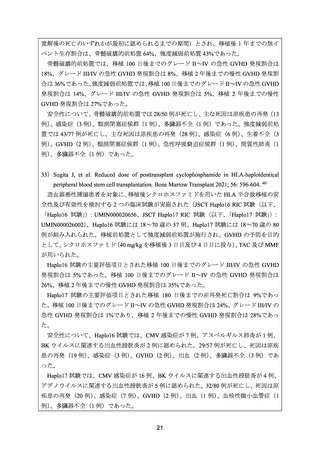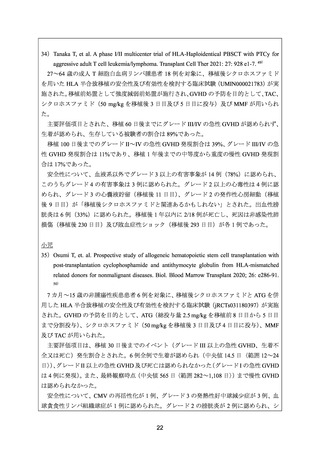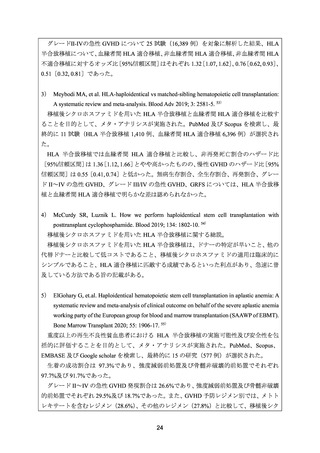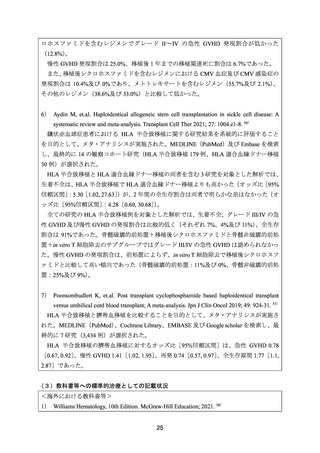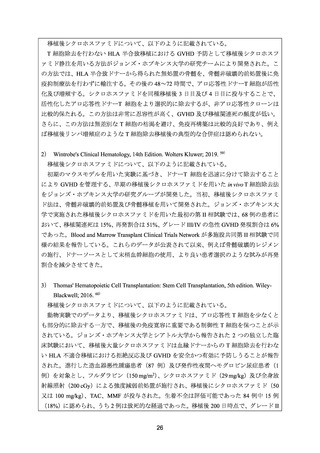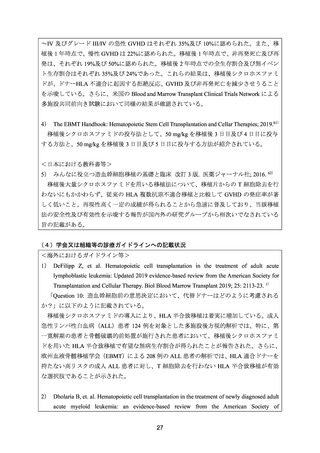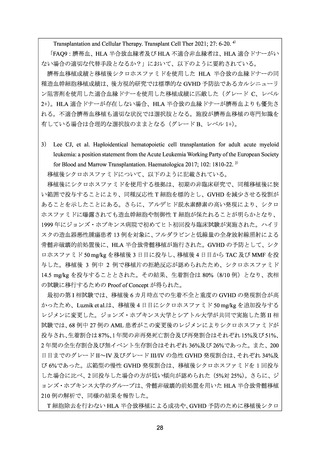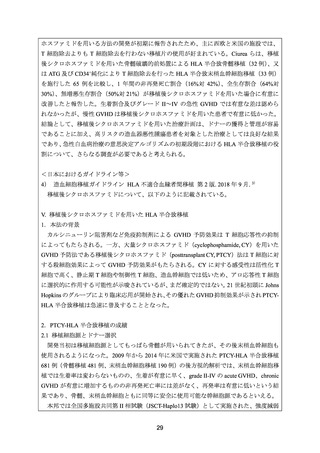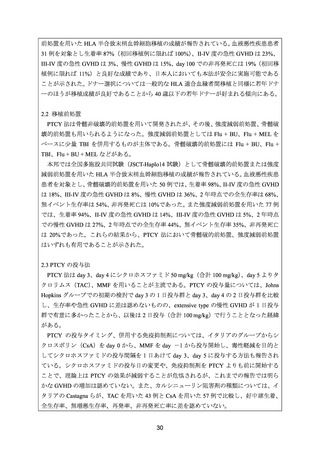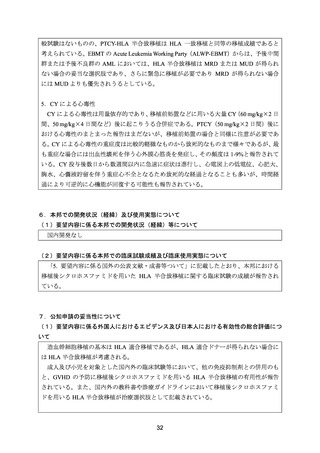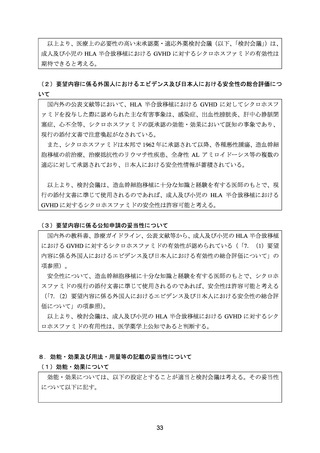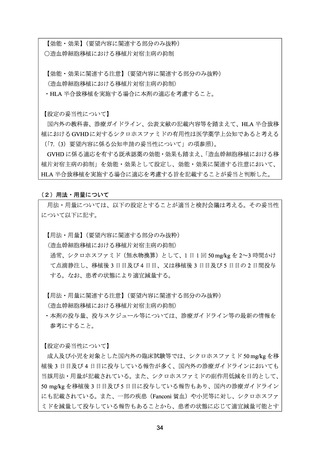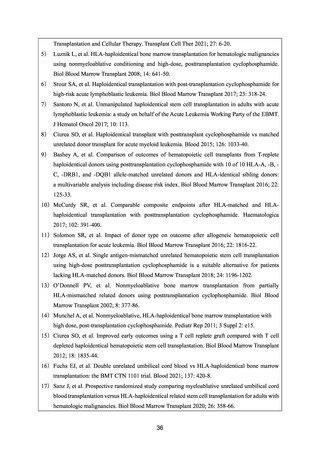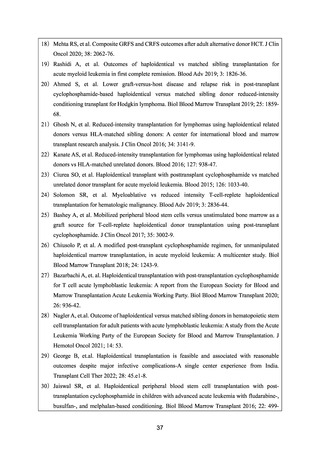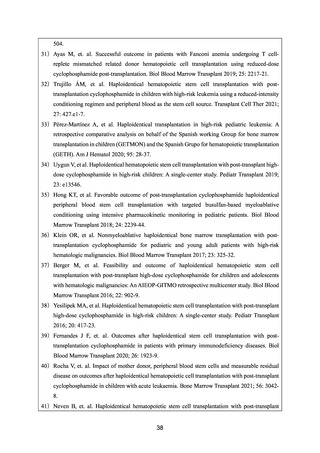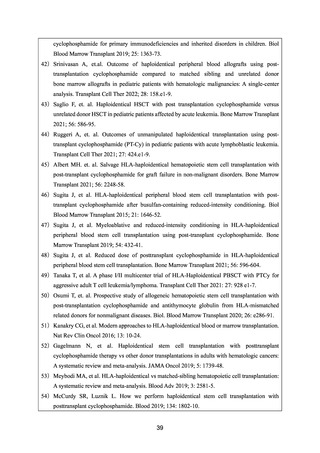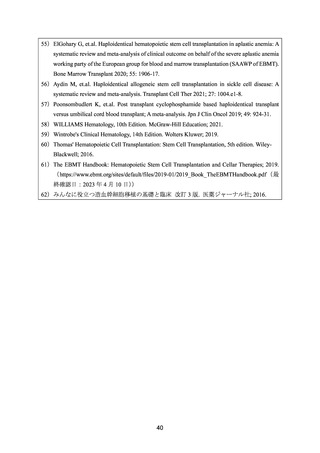よむ、つかう、まなぶ。
資料4 シクロホスファミド水和物 (36 ページ)
出典
| 公開元URL | https://www.mhlw.go.jp/stf/shingi2/0000198856_00027.html |
| 出典情報 | 医療上の必要性の高い未承認薬・適応外薬検討会議(第55回 5/31)《厚生労働省》 |
ページ画像
ダウンロードした画像を利用する際は「出典情報」を明記してください。
低解像度画像をダウンロード
プレーンテキスト
資料テキストはコンピュータによる自動処理で生成されており、完全に資料と一致しない場合があります。
テキストをコピーしてご利用いただく際は資料と付け合わせてご確認ください。
Transplantation and Cellular Therapy. Transplant Cell Ther 2021; 27: 6-20.
5) Luznik L, et al. HLA-haploidentical bone marrow transplantation for hematologic malignancies
using nonmyeloablative conditioning and high-dose, posttransplantation cyclophosphamide.
Biol Blood Marrow Transplant 2008; 14: 641-50.
6) Srour SA, et al. Haploidentical transplantation with post-transplantation cyclophosphamide for
high-risk acute lymphoblastic leukemia. Biol Blood Marrow Transplant 2017; 23: 318-24.
7) Santoro N, et al. Unmanipulated haploidentical stem cell transplantation in adults with acute
lymphoblastic leukemia: a study on behalf of the Acute Leukemia Working Party of the EBMT.
J Hematol Oncol 2017; 10: 113.
8) Ciurea SO, et al. Haploidentical transplant with posttransplant cyclophosphamide vs matched
unrelated donor transplant for acute myeloid leukemia. Blood 2015; 126: 1033-40.
9) Bashey A, et al. Comparison of outcomes of hematopoietic cell transplants from T-replete
haploidentical donors using posttransplantation cyclophosphamide with 10 of 10 HLA-A, -B, C, -DRB1, and -DQB1 allele-matched unrelated donors and HLA-identical sibling donors:
a multivariable analysis including disease risk index. Biol Blood Marrow Transplant 2016; 22:
125-33.
10) McCurdy SR, et al. Comparable composite endpoints after HLA-matched and HLAhaploidentical transplantation with posttransplantation cyclophosphamide. Haematologica
2017; 102: 391-400.
11) Solomon SR, et al. Impact of donor type on outcome after allogeneic hematopoietic cell
transplantation for acute leukemia. Biol Blood Marrow Transplant 2016; 22: 1816-22.
12) Jorge AS, et al. Single antigen-mismatched unrelated hematopoietic stem cell transplantation
using high-dose posttransplantation cyclophosphamide is a suitable alternative for patients
lacking HLA-matched donors. Biol Blood Marrow Transplant 2018; 24: 1196-1202.
13) O’Donnell PV, et al. Nonmyeloablative bone marrow transplantation from partially
HLA-mismatched related donors using posttransplantation cyclophosphamide. Biol Blood
Marrow Transplant 2002; 8: 377-86.
14) Munchel A, et al. Nonmyeloablative, HLA-haploidentical bone marrow transplantation with
high dose, post-transplantation cyclophosphamide. Pediatr Rep 2011; 3 Suppl 2: e15.
15) Ciurea SO, et al. Improved early outcomes using a T cell replete graft compared with T cell
depleted haploidentical hematopoietic stem cell transplantation. Biol Blood Marrow Transplant
2012; 18: 1835-44.
16) Fuchs EJ, et al. Double unrelated umbilical cord blood vs HLA-haploidentical bone marrow
transplantation: the BMT CTN 1101 trial. Blood 2021; 137: 420-8.
17) Sanz J, et al. Prospective randomized study comparing myeloablative unrelated umbilical cord
blood transplantation versus HLA-haploidentical related stem cell transplantation for adults with
hematologic malignancies. Biol Blood Marrow Transplant 2020; 26: 358-66.
36
5) Luznik L, et al. HLA-haploidentical bone marrow transplantation for hematologic malignancies
using nonmyeloablative conditioning and high-dose, posttransplantation cyclophosphamide.
Biol Blood Marrow Transplant 2008; 14: 641-50.
6) Srour SA, et al. Haploidentical transplantation with post-transplantation cyclophosphamide for
high-risk acute lymphoblastic leukemia. Biol Blood Marrow Transplant 2017; 23: 318-24.
7) Santoro N, et al. Unmanipulated haploidentical stem cell transplantation in adults with acute
lymphoblastic leukemia: a study on behalf of the Acute Leukemia Working Party of the EBMT.
J Hematol Oncol 2017; 10: 113.
8) Ciurea SO, et al. Haploidentical transplant with posttransplant cyclophosphamide vs matched
unrelated donor transplant for acute myeloid leukemia. Blood 2015; 126: 1033-40.
9) Bashey A, et al. Comparison of outcomes of hematopoietic cell transplants from T-replete
haploidentical donors using posttransplantation cyclophosphamide with 10 of 10 HLA-A, -B, C, -DRB1, and -DQB1 allele-matched unrelated donors and HLA-identical sibling donors:
a multivariable analysis including disease risk index. Biol Blood Marrow Transplant 2016; 22:
125-33.
10) McCurdy SR, et al. Comparable composite endpoints after HLA-matched and HLAhaploidentical transplantation with posttransplantation cyclophosphamide. Haematologica
2017; 102: 391-400.
11) Solomon SR, et al. Impact of donor type on outcome after allogeneic hematopoietic cell
transplantation for acute leukemia. Biol Blood Marrow Transplant 2016; 22: 1816-22.
12) Jorge AS, et al. Single antigen-mismatched unrelated hematopoietic stem cell transplantation
using high-dose posttransplantation cyclophosphamide is a suitable alternative for patients
lacking HLA-matched donors. Biol Blood Marrow Transplant 2018; 24: 1196-1202.
13) O’Donnell PV, et al. Nonmyeloablative bone marrow transplantation from partially
HLA-mismatched related donors using posttransplantation cyclophosphamide. Biol Blood
Marrow Transplant 2002; 8: 377-86.
14) Munchel A, et al. Nonmyeloablative, HLA-haploidentical bone marrow transplantation with
high dose, post-transplantation cyclophosphamide. Pediatr Rep 2011; 3 Suppl 2: e15.
15) Ciurea SO, et al. Improved early outcomes using a T cell replete graft compared with T cell
depleted haploidentical hematopoietic stem cell transplantation. Biol Blood Marrow Transplant
2012; 18: 1835-44.
16) Fuchs EJ, et al. Double unrelated umbilical cord blood vs HLA-haploidentical bone marrow
transplantation: the BMT CTN 1101 trial. Blood 2021; 137: 420-8.
17) Sanz J, et al. Prospective randomized study comparing myeloablative unrelated umbilical cord
blood transplantation versus HLA-haploidentical related stem cell transplantation for adults with
hematologic malignancies. Biol Blood Marrow Transplant 2020; 26: 358-66.
36







